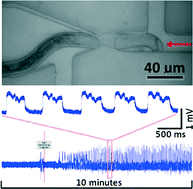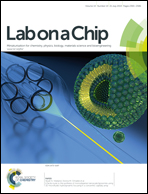StyletChip: a microfluidic device for recording host invasion behaviour and feeding of plant parasitic nematodes†
Abstract
Plant parasitic nematodes (PPNs) infest the roots of crops and cause global losses with a severe economic impact on food production. Current chemical control agents are being removed from use due to environmental and toxicity concerns and there is a need for new approaches to crop protection. A key feature of parasitic behaviour for the majority of PPNs is a hollow stomastyle or odontostyle required for interaction with the host plant and feeding. This lance-like microscopic structure, often called a stylet, protrudes from the mouth of the worm and thrusts in a rhythmic manner to stab the host root. Studying stylet activity presents technical challenges and as a consequence the underlying biology is poorly understood. We have addressed this by designing a microfluidic chip which traps the PPN Globodera pallida and permits the recording of an electrophysiological signal concomitant with stylet thrusting. The PDMS chip incorporates a precisely designed aperture to trap the nematode securely around a mid-point of its body. It is fabricated using a novel combination of conventional photolithography and two photon polymerization. The chip incorporates valves for rapid application of test compounds and integral electrodes to facilitate acquisition of electrical signals. We show that stylet thrusting can be induced by controlled application of 5-HT (serotonin) to the worm. Each thrust and retraction produces an electrical waveform that characterises the physiological activity associated with the worm's behaviour. The ability to reproducibly record the stylet activity of PPNs provides a new platform for nematicide screening that specifically focuses on a behaviour that is integral to the parasite host interaction. This is the first report of a microfluidic chip capable of electrophysiological recording from nematodes other than Caenorhabditis elegans. The unique approach is optimised for trapping and recording from smaller worms or worms with distinct anterior body shapes and may be applied to other species of economic or medical importance.


 Please wait while we load your content...
Please wait while we load your content...